Sep-30-13
 | | Chessical: Showalter allows Schlechter a brief opportunity with <46.Ke4?> to win this otherwise drawn K+Ps ending
click for larger viewafter <46...Kd6>.
Instead, the drawing line was to sacrifice the <b> pawn to create a fortress: <46. b4!> axb4 47. b3 Kc5 48. f4 Kc6 49. Ke4 (<49. Kd4?> loses to 49... Kd6) 49... Kd6 50. Kd4 Ke6 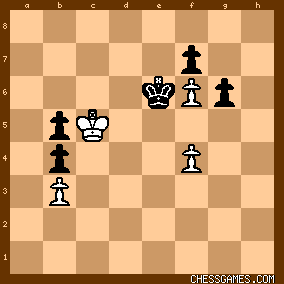
click for larger view<51. Kc5> Kxf6 52. Kxb5 Kf5 53. Kxb4 Kxf4 54. Ka5 f5 55. b4 = |
|
Feb-10-16
 | | Mateo: <Chessical> This is a very interesting K + P ending. I am a bit surprised by your eval. If we go further, Black gets a Q + P vs Q ending. 55...Kg4 56.b5 f4 57.b6 f3 58.b7 f2 59.b8Q f1 Q. Black has winning prospects, I think. Schlechter missed something to take the draw or... I did. |
|
Feb-11-16
 | | Chessical: <Mateo> At the end of the proposed variation <46. b4 axb4 47. b3 Kc5 48. f4 Kc6 49. Ke4 Kd6 50. Kd4 Ke6 51. Kc5 Kxf6 52. Kxb5 Kf5 53. Kxb4 Kxf4 54. Ka5 f5 55. b4 Kg4 56. b5 f4 57. b6 f3 58. b7 f2 59. b8=Q f1=Q> we have this position:

click for larger viewI believe this is a draw as the Black King cannot escape from checks without eventually blocking his pawn. Nor can he force off the Queens. For instance: <60. Qb4+> Qf4 61. Qe1 g5 62. Qd1+ Kf5 63. Qc2+ Ke6 64. Qc6+ Qd6 65. Qc8+ Ke5 66. Qh8+ Kf5 67. Qh7+ Qg6 68. Qd7+ Qe6 69. Qd3+ Qe4 70.Qf1 ... 
click for larger view |
|
Jun-30-18
 | | KEG: After a closely contested game, Showalter and Schlechter reached a pawn ending that should have been a draw. But Showalter erred and--as <Chessical> has brilliantly demonstrated--Schlechter has a won game. Chessical's analysis is wonderful. BRAVO Chessical. Like Mateo, I didn't believe it at first, but after a sleepless night I was persuaded. Indeed, as I will attempt to show in my posts on this game, by extending Chessical's reasoning, it appears that Schlechter had wins both before and after the point that Chessical has so thoroughly analyzed (and indeed had a win at the very point at which he agreed to a draw. But let us start at the beginning.
1. e4 e5
2. Nf3 Nc6
3. Bb5 a6
4. Ba4 Nf6
5. Qe2
The Wormald Variation. This close analogue to the Howell Attack is almost certainly inferior to 5. 0-0 or even 5. d4. But it is certainly playable and a reasonable choice to throw an opponent on unfamiliar territory. 5... b5
6. Bb3 Bc5
7. c3
Another efforts to avoid the beaten track, but 7. a4 or 7. 0-0 were--at least theoretically--better options. 7... d6
8. d3 Be6
8...0-0 or 8...h6 or 8...Bd7 were all better.
The position after the text was:
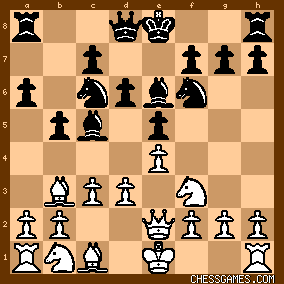
click for larger viewSchlechter's move was the first of a strange sequence in which Showalter could have played BxB but declined to do so, and Schlechter could also have traded Bishops, but also declined to do so until his 15th move. 9. Nbd2
White's game now gets clogged. 9. BxB was better. Nbd2 is often a useful move in the Ruy Lopez, trading Bishops first was far better for Showalter here. 9... 0-0
9...BxB or 9...Bd7 or 9...Qd7 were better.
10. Nf1
Once again, Showalter should have traded Bishops. 10... Ne7
10...Qd7 or 10...h6 or 10...BxB were all better. 11. h3
He should have played 11. BxB or 11. Ng3.
11... Ng6
The position was now:

click for larger viewChances were about equal here. But at this point, as I will discuss in my next post on this game, Showalter launched a highly questionable King-side advance that could have landed him in trouble. |
|
Jun-30-18
 | | KEG: Post II
12. g4?!
This Tahl-like gesture could have landed him (since Showalter was not Tahl) into hot water. 12. BxB or the prosaic 12. Ne3 or 12. Ng3 were all much sounded and better choices. 12... Re8
Playing to exploit White's Queen-King line-up on the e-file. But 12...d5 was much stronger and would have given Schlechter an excellent game. 13. Ng3
Once again, why not BxB?
13... Nf4
Yet again Schlechter could have obtained much the better game with 13...d5. The text heralds a series of exchanges that yield an approximately even game. 14. BxN exB
Is this doubled pawn a weakness or a dangerous thorn in White's King-side? Only time would tell. 15. Nf5 BxB
This long-delayed trade is finally initiated. But here, 15...a5, 15...Nd7, or 15...Bb6 were all better choices. 16. axB g6
This left:

click for larger view17. Nh6+ Kg7
18. g5
Better than the tempting but inferior 18. b4?! d5! 18... Nh5
19. Ng4 c6
19...d5 was much stronger. Schlecther is courting trouble with the text. 20. d4
20. b4 was indicated.
20... Bb6
21. Rg1
White should have solved his problems on the e-file with 21. Kf1. 21... Qe7.
Schlechter is too eager to play on the e-file. 21...Qd7 was best. 22. e5
"!" -- Tournament Book.
This excellent move was the only way for Showalter to stay out of trouble here. The position was now:

click for larger view22... dxe5
Schlechter should have played 22...Kh8 before opening the position. 23. dxe5
Missing his chance to obtain excellent winning chances with 23. Qxe5+. White would then have had a powerful position after the exchange of Queens: e.g., 23. Qxe5+ QxQ+ 24. dxQ Re6 25. 0-0-0. 23... Qe6
24. Nf6
"!"--Tournament Book.
The Tournament Book's approval of the text notwithstanding, 24. b4 was the only way for White to obtain an edge here. 24... NxN
25. exN+ Kg8
26. QxQ+
Entering an approximately even ending. The odd pawn formations on the Queen-side, however, make a draw anything but inevitable here. 26... RxQ+
27. Kf1
The position was now:

click for larger viewAlthough the Queens were now off the board and material was even, both sides have chances here. I will discuss the ensuing struggle in my next post on this game. |
|
Jun-30-18
 | | KEG: Post III
What a complicated and fascinating endgame! Both sides had doubled f-pawns. Both sides had weaknesses. And both sides had prospects of attack, Showalter on the King-side and Schlechter on the Queen-side. A battle royale was in the offing. 27... a5
Restricting the advance of White's weak b-pawn. As will be seen, the possibility of White playing b4--and of Black doing likewise--was to be a recurring theme in this ending. 28. Rg4
Targeting Black's weak pawn on f4.
28... h6
Threatening to break up White's King-side pawn mass. 29. h4 Rae8
"!"--Tournament Book.
Indirectly defending the pawn on f4, since if 30. Rxf4 Re2! 30. Re1
Offering to trade off a pair of Rooks to ease the pressure. Schlechter, reasonably, obliges. 30... RxR+
31. NxR hxg5
32. hxg5
This left:

click for larger view32... Bc7?
This should have led to problems for Schlechter. 32...Re5 was the better way to protect the f4 pawn. 33. Ng2?
Missing his chance. 33. Nf3 was much etter.
33... Re5
"!"--Tournament Book.
Correcting his error on move 33.
34. f3
Another weak move by Showalter. He should have tried 34. Ne1 or 34. Nh4. 34... Rc5
This Rook would be better placed on f5 or d5. 34...Bb6 was another good possibility (35. Nxf4 Re3!). 35. Ke2 Rd5
Tacitly agreeing to the coming exchanges.
36. Nxf4 BxN
37. RxB Rxg5
The position now was:
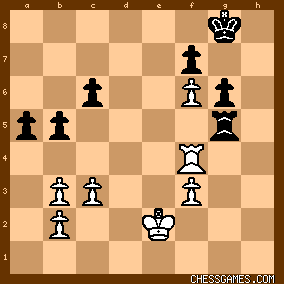
click for larger viewBlack certainly seems better, but Showalter should be able to hold the position and obtain a draw. But there is a lot of play left in this Rook endgame--and in the pawn ending that results from it--as I will discuss in my next post on this game. |
|
Jul-06-18
 | | KEG: Post IV
38. Kf2 Rd5
39. Rd4
"!"--Tournament Book.
As first site, this offer to trade Rooks and enter a King and pawn ending with such weak pawns appears suicidal. In fact, and as I will attempt to show, Showalter's move was just fine since he in fact can hold the game with best play. 39... RxR
40. dxR
This left the players with the following King and Pawn ending: 
click for larger viewWhite's weaknesses are obvious: isolated doubled f-pawns, an isolated d-pawn, and isolated doubled b-pawns. But White can counter with a blockade--with very careful play. 40... Kf8
Immediately targeting White's weak pawns.
41. Ke3
White has no time to lose to defend against incursion by the Black King. Showalter could also hold off Black with an immediate 41. b4 or 41. Kg3. 41... Ke8
42. Ke4
Or 42. b4
42... Kd7
43. Ke5
Forced. Showalter must keep Schlechter's King from reaching d6 43... Kc7
Keeping his King within one square of d6 and thus preventing any retreat by the White King. The position now was:
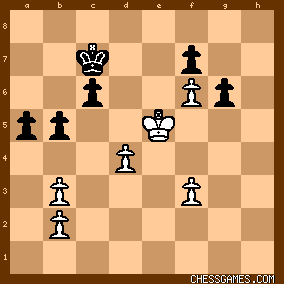
click for larger viewBefore going any further, I strongly suggest that anyone reading this post first review the excellent post by Chessical concerning the possibilities of 46. b4 by White and 46...b4 by Black. The following analysis presupposes and was strongly influenced by Chessical's findings, even as I attempt to extend his ideas. His key notion is the criticality of the square b4. 44. d5??
This move should have lost the game for Showalter. The only saving move in the above-diagrammed position is 44. b4! This leads--by an extension of Chessical's ideas--to the following line: 44. b4! axb4 (forced) 45. b3 (forced) Kd7 46. Kf4 (forced--White can now allow Black's King to reach d6 since he now can penetrate) Kd6 47. Kg5 Kd5 48. Kh6 Kxd4 49. Kg7 c5 (forced) 50. Kxf7 c4 (forced) 51. bxc4 Kxc4 (51...bxc4 is no better) 52. Kg7 b3 53. f7 b2 54. f8(Q) b1(Q) 55. Qf4+ The position would then be: 
click for larger viewThis is a book draw.
After 44. d5, by contrast, Schlechter had a win, the position being: 
click for larger viewAs I will show in my next post, Schlechter now had a win--which he missed. |
|
Jul-06-18
 | | KEG: Post V
After 44. d5??, Schlechter had a win with 44...b4! (by an extension of Chessical's analysis--i.e., blocking White's chance to play b4 himself): i.e., 44...b4! 45. d6+ Kd8 46. Kd4 (46. f4 Kd7 would lose even faster) Kd7 47. Ke5 g5! (47...Kc8 probably also wins, but g5 is immediately crushing) 48. Kf5 Kxd6 49. Kxg6 Ke5 and White's goose is cooked. The position being: 
click for larger viewThe f6 pawn falls and White is toast.
But instead of the winning 44...b4!, Schlechter played 45...Kd7?, giving Showalter a fighting chance. 45. dxc6+ Kxc6
The position now was:

click for larger viewAs Chessical has brilliantly demonstrated (I didn't believe my eyes until I examined Chessical's analyis more closely), 46. b4 allows White to save the game through a blockade after 46...axb4 47. b3 (which reduces to a Queen and pawn endgame in which White--though a pawn down--has a book draw. Once again...BRAVO Chessical. But instead of playing Chessical's move, Showalter erred with 46. Ke4?
The position now was:
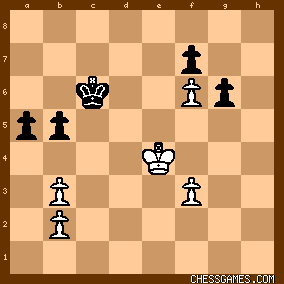
click for larger viewAs Chessical has shown, Schlecther now had a win with 46...b4! Instead, he played:
46... Kc5
Here I differ from Chessical. The text itself did not blow the win. 47. Ke5
As is obvious, White could not play b4 here (47. b4 axb4 48. b3 Kd6 and the f6 pawn falls). The text, however, should not have saved the game for White. The position now was:

click for larger viewHere, extending Chessical analysis, Schlechter could have won with 47...b4! But instead Schlechter played the move that should have blown the win: 47... Kc6?
Now, Showalter could have saved himself (again following Chessical's analysis) with 48. b4! But instead he played: 48. Ke4?
Now Schlechter could have won immediately with 48...b4! 48... Kc5
This misses the immediate win with 48...b4, but still leaves Schlechter with the win he had two moves earlier. Yet here--incredibly--he agreed to a draw in this won position. The lost half-point for Schlechter was costly, given that he ultimately tied for first with Pillsbury and Maroczy. |
|
|
|
|





